Real Estate
How to Select the Right Construction Management Software for Your Business
June 20, 2025 • 129 Views • 34 min read
Tetiana Stoyko
CTO & Co-Founder
The variety of ready-made software solutions for the construction industry is vast, offering businesses numerous options tailored to their preferences and needs. Yet, the variety of SaaS solutions can make it challenging to select the right system. For instance, according to the latest statistics, the quick and accurate cost calculation feature is the most requested feature, demanded by 60% of respondents.
Unfortunately, based on our deep research, ready-made construction software systems often lack efficient budget planning and other financial management tools.
One of the core challenges is the fact that most such systems share standard functionality. Yet, the efficiency and accuracy of offered features can significantly differ from platform to platform.
Therefore, we have compiled this guide on how to choose a construction management software if you are looking to adopt one of the existing solutions.
What to Look for in Construction Project Management Software?
First, define your goals and business needs that you plan to enhance with the use of ready-made solutions. Creating a list of top-priority functionality, as demanded by your business logic and needs, helps narrow down the list of SaaS options and is highly personalized. However, we can highlight the most crucial and common features offered by most such ready-made software.
Core Features Every Construction Software Should Have

When it comes to choosing construction management solutions, it is vital to ensure that they offer tools for:
- Project scheduling, planning, and tracking to boost teams’ awareness of ongoing processes, as well as enable a convenient planning routine, track tasks and deadlines, and more.
- Document management and internal communication methods help centralize collaboration and data sharing within the project, making it easier and faster to share crucial or real-time information between different departments and teams.
- Site and field management is a specialized service for overseeing construction operations and processes.
- Documentation management, including secure storage, sharing, and analysis. Additionally, some services offer smart contracts and other innovative features for working with documents and files, although these extra services are optional.
- Financial and cost management, including budget planning and monitoring, invoice operations, and reporting on all financial processes, such as expenses, resource allocation, and material management.
However, not every construction project management software solution can provide its users with all the foregoing built-in instruments and features. To address these functional gaps or ensure the possibility of future software scaling, it is vital to pay attention to the system’s integration and collaboration capabilities.
Integration Capabilities
Software integration and collaboration features are a must-have even for the simplest construction planning software. In brief, software integration is a mechanism that connects various software solutions, enabling seamless data sharing between them.
Based on our experience in construction software development, it is almost impossible to find an off-the-shelf construction management platform that consistently meets your business needs and demands.
One day, the offered services won’t be enough, and you will need to either scale existing functionality through custom development or utilize other third-party SaaS solutions that provide better niche services, such as financial management.
Therefore, it is crucial to plan such flexibility and connectivity to avoid future inconveniences or functional limitations.
In fact, creating a multi-platform system that consists of different interconnected SaaS solutions is a standard service offered by any bespoke software development company. It helps to overcome software limitations or functional gaps by utilizing the best aspects of each chosen software service.
Let’s suppose you are satisfied with the Procore construction management system, yet lack the client-oriented features like a client portal. Custom software development can deliver such services in a few ways:
- Create it from scratch and link it with Procore to enable data sharing and provide clients with only relevant information.
- Create a custom integration module that connects and synchronizes the Procore system with Aconex or other alternatives offering customer-oriented features.
Once again, it is essential to ensure the construction SaaS you plan to adopt for your business needs can be scaled with custom construction IT services, even if you don’t plan such projects in the future.
Based on our experience, many pain points become apparent only after using off-the-shelf software for some time. For example, most construction workflow management solutions offer built-in Gantt charts that are not tied to real-time delivery and price changes. As a result, it becomes a burden, requiring manual entries or displaying outdated information otherwise.
The solution? Thanks to custom software development, it is possible to set up a dynamic Gantt chart integration that enables real-time updates to delivery schedules and pricing.
Frankly, the variety of such pitfalls is countless. Fortunately, there are many ways to address them, thanks to custom software development. For instance:
Issues with inaccurate budgeting and estimation resulting from manual planning tools can be easily resolved using a live budget sync engine and automated cost forecasting.
The lack of analysis at the pre-construction stage can be fixed by integrating an AI assistant for data analysis.
Outdated project execution can be solved by custom dynamic tracking.
And this is just the tip of the iceberg of potential issues that may be faced in ready-made software. Fortunately, most of these issues can be addressed and resolved with the help of custom software development and integration, which many software development companies, such as Incora, offer.
If you need custom modules but didn’t consider the integration capabilities at first, it would be either impossible to implement or would require a lot of extra effort and steps, such as migrating to another ready-made platform. So, don’t hesitate to drop us a line and ask for advice!
Comparison of Leading Construction Management Solutions
As we mentioned above, each off-the-shelf construction management solution has its functional limitations. Combined with the overall variety of SaaS solutions on the modern market, it makes it almost impossible to conduct a comprehensive comparison of all existing tools.
Instead, we decided to examine and compare the most popular and complete construction management solutions, including:
- Procore
- Buildertrend
- PlanRadar
- Aconex
- LetsBuid
- BuildSmart
Let’s consider each of the solutions from the list to better understand the pros and cons of these popular, ready-made construction software systems and learn how to overcome their drawbacks, if possible.
Procore
Price: 375-549$/month Best for: Large enterprises, complex projects
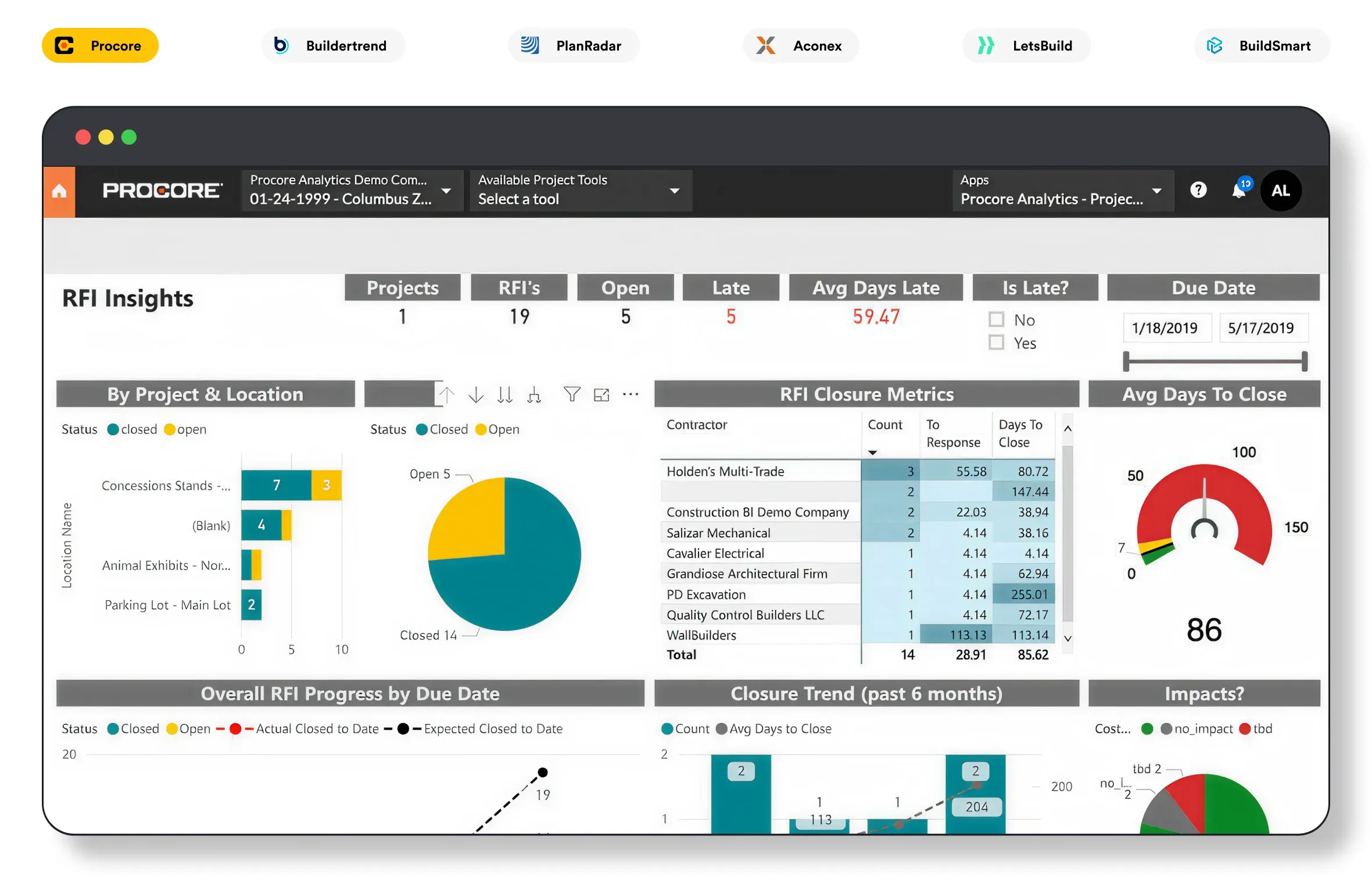
Procore is a top-tier construction software on the US market. However, it is also rapidly gaining popularity among European and Middle Eastern construction companies.
The reason for such market dominance is quite apparent and straightforward: this centralized platform offers the most comprehensive set of industry-specific features required by such companies. Therefore, we can use it as an example of the best construction SaaS available on the market.
One of the most distinctive advantages of Procore is that it offers an end-to-end platform, covering document management, project planning, Request for Information (RFI) management, reporting, budget tracking, quality control, safety features, and numerous third-party integrations.
-
Substantial real-time project updates feature allows all involved parties, such as contractors, owners, architects, subcontractors, and various stakeholders, to stay informed and notified of all changes and updates regarding each project 24/7.
-
Efficient data management methods are the core reason why such features are possible. This platform consolidates data-related aspects, including documentation management, estimates, schedules, and reports, in a single workspace with built-in communication tools. Therefore, data operations are more straightforward and accessible for all parties while also being protected by sophisticated security measures.
-
Comprehensive project controls are also provided by the Procore Platform. They include streamlining planning, scheduling, and progress tracking, with robust tools for document control, including RFIs, submittals, and blueprints. This platform also provides some tools for cost management and monitoring.
Procore Limitations
Despite the end-to-end coverage of construction management essentials, Procore still has limitations.
-
Сustomization options are minimal and inconvenient: It supports third-party integrations, as well as some hard-coded features, although these are limited compared to the other SaaS alternatives listed above. Moreover, despite Procore supporting over 300 third-party software tools, some of them lack efficiency and require extensive quality assurance and troubleshooting to ensure a seamless connection.
-
It is challenging to navigate: Procore is a highly complex system with a high input threshold, making it difficult to use effectively. It doesn’t adhere to strict guidelines or rules, so teams can set it up differently, which can result in further confusion. Fortunately, it is possible to avoid such inconvenience by assigning dedicated administrators and clarifying each team member's role.
-
Built-in Financial management is complex: it requires a careful approach during setup. Connecting these tools with fintech solutions and integrating data sharing as well as synchronization between Procore & specialized financial services requires a certain level of expertise. Additionally, numerous reports have been made of sync errors and the need for manual data entry.
Buildertrend
Price: 199-799$/month Best for: small-medium residential builders
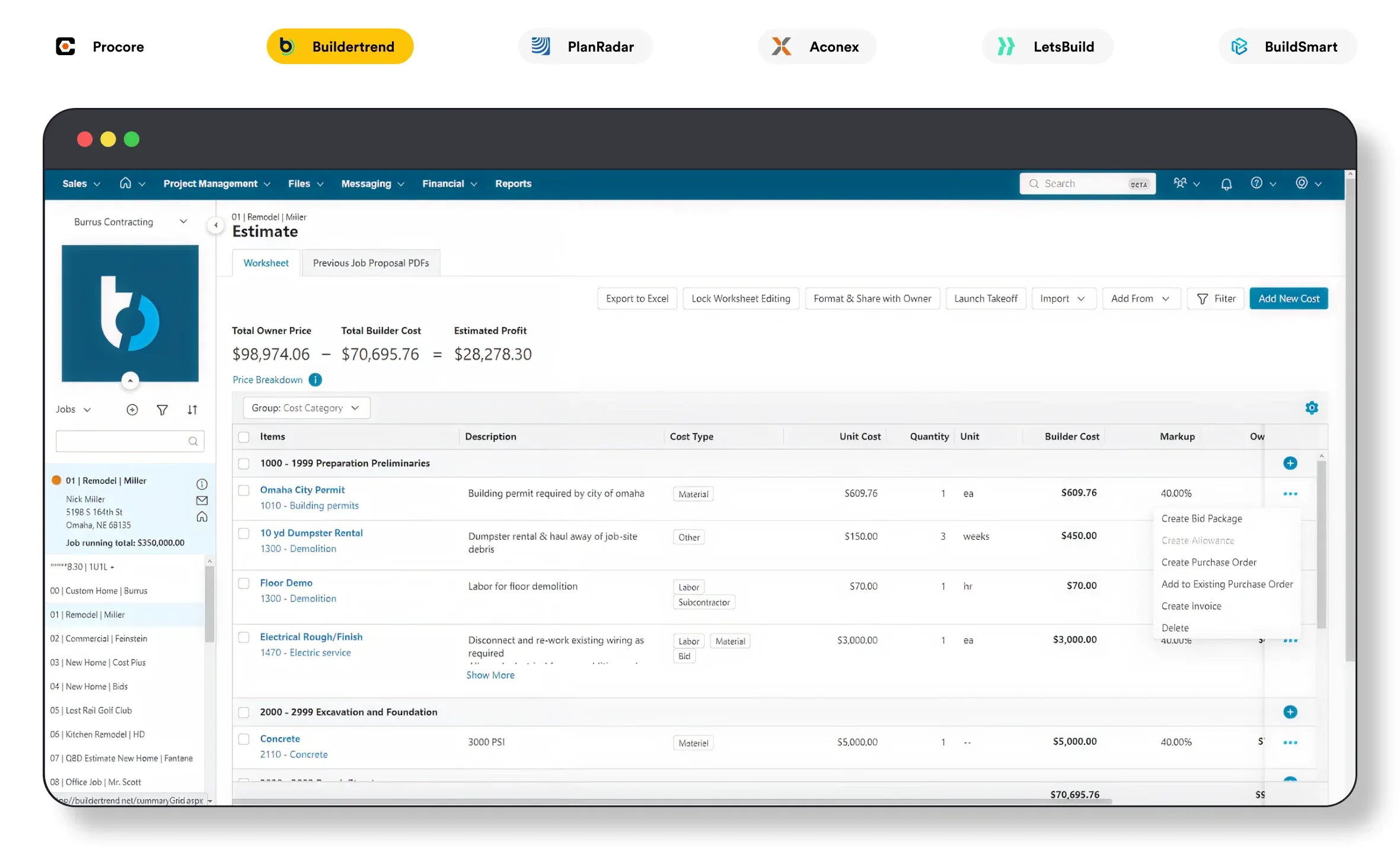
Similar to Procore, Buildertrend offers numerous features and services essential for construction project management software, including multiple helpful tools for management and budget planning. It also supports third-party integrations and offers considerable flexibility in terms of platform customization and personalization.
-
Client-oriented functionality, such as a client portal: Such features are primarily designed to enhance customer engagement and satisfaction, enabling clients to stay informed about any changes or progress related to their investments.
-
Built-in construction and property tracking options: Property owners or other stakeholders can track their property's status and plan further investments, renovations, and other actions. By keeping customers informed about the current on-site situation, thanks to Buildertrend, construction companies can establish more efficient and trustworthy relationships with their clients, fostering seamless and transparent communication.
-
Ready-made Construction CRM software as a service: It enables construction businesses to track their customer relationships more effectively, understand customer needs and expectations more accurately, and adjust their projects to deliver more competitive and client-oriented services in the future.
-
Enhanced internal communication: the platform provides companies and their employees with a secure, built-in messenger, to-do lists, reports, logs, notifications, and other collaboration tools that help boost collaboration between different teams.
Buildertend Flaws
Unlike Procore, Buildertrend is less scalable, making it more suitable for mid-sized companies rather than small businesses or enterprises.
For LARGE companies:
Large companies using Buildertrend will face connectivity and integration issues between different modules and services. Apart from that, the platform doesn’t support comprehensive multi-project oversight and other management tools and options for dealing with or monitoring multiple projects or objects simultaneously.
For SMALL companies:
Small companies will likely prefer other Buildertend alternatives due to the high costs of such SaaS (around $200 per user per month), as stated in numerous feedback.
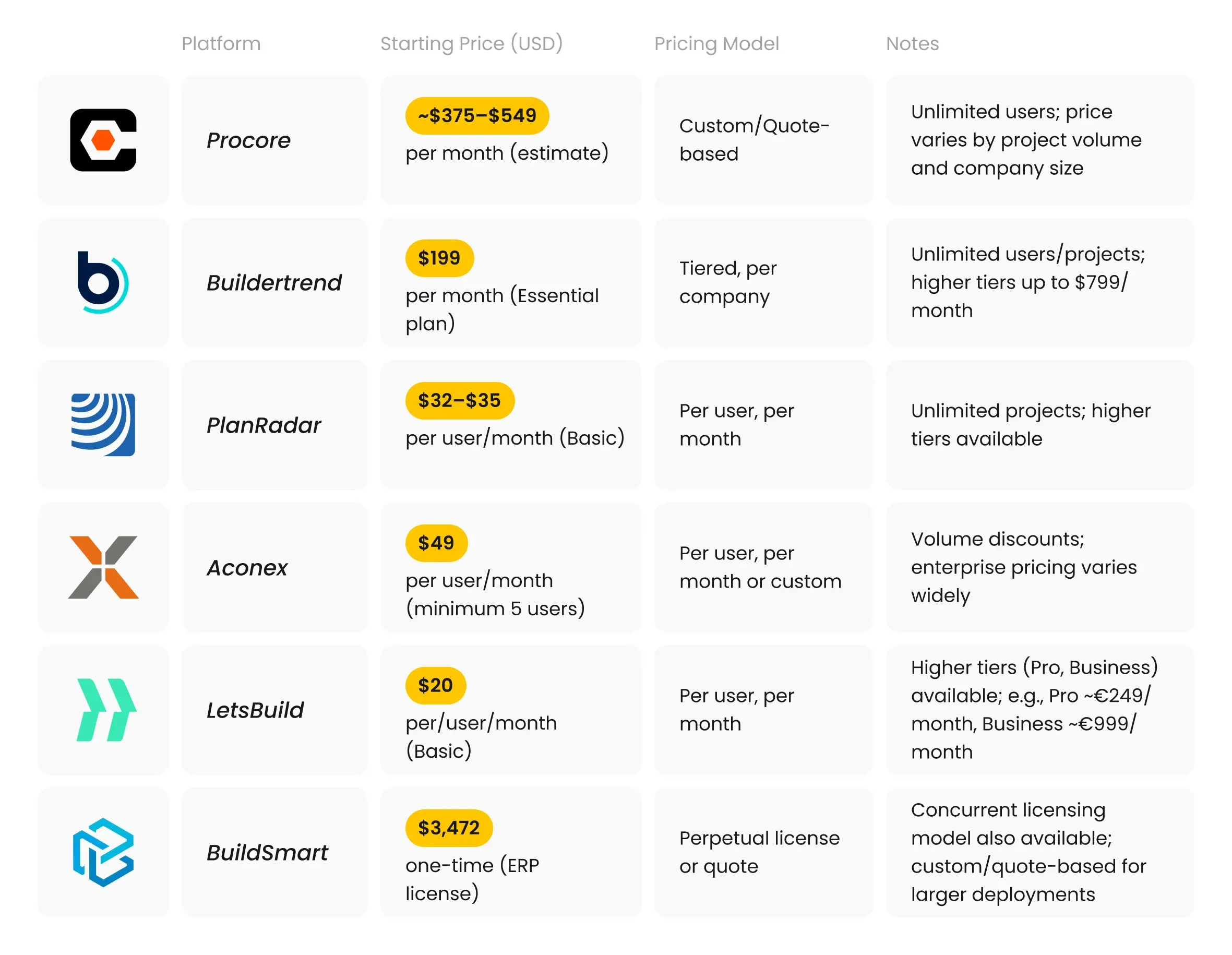
Additionally, despite the variety of available features and software tools, many of them lack efficiency and require additional optimization and scaling. For illustration, the financial instruments offered by Buildertrend are relatively basic and underperform compared to alternatives, making them less valuable and useful for the end-user.
TIP: It's worth testing Buildertrend before adopting it into your construction business for site or project management.
Otherwise, you might face the need to pay for services you won’t use while spending extra resources on third-party services for financial management.
Nevertheless, Buildertrend is a highly popular solution among mid-sized construction firms, especially in the UK, Ireland, and the United States.
PlanRadar
Price: 32-35$/month (per user) Best for: defect management, documentation
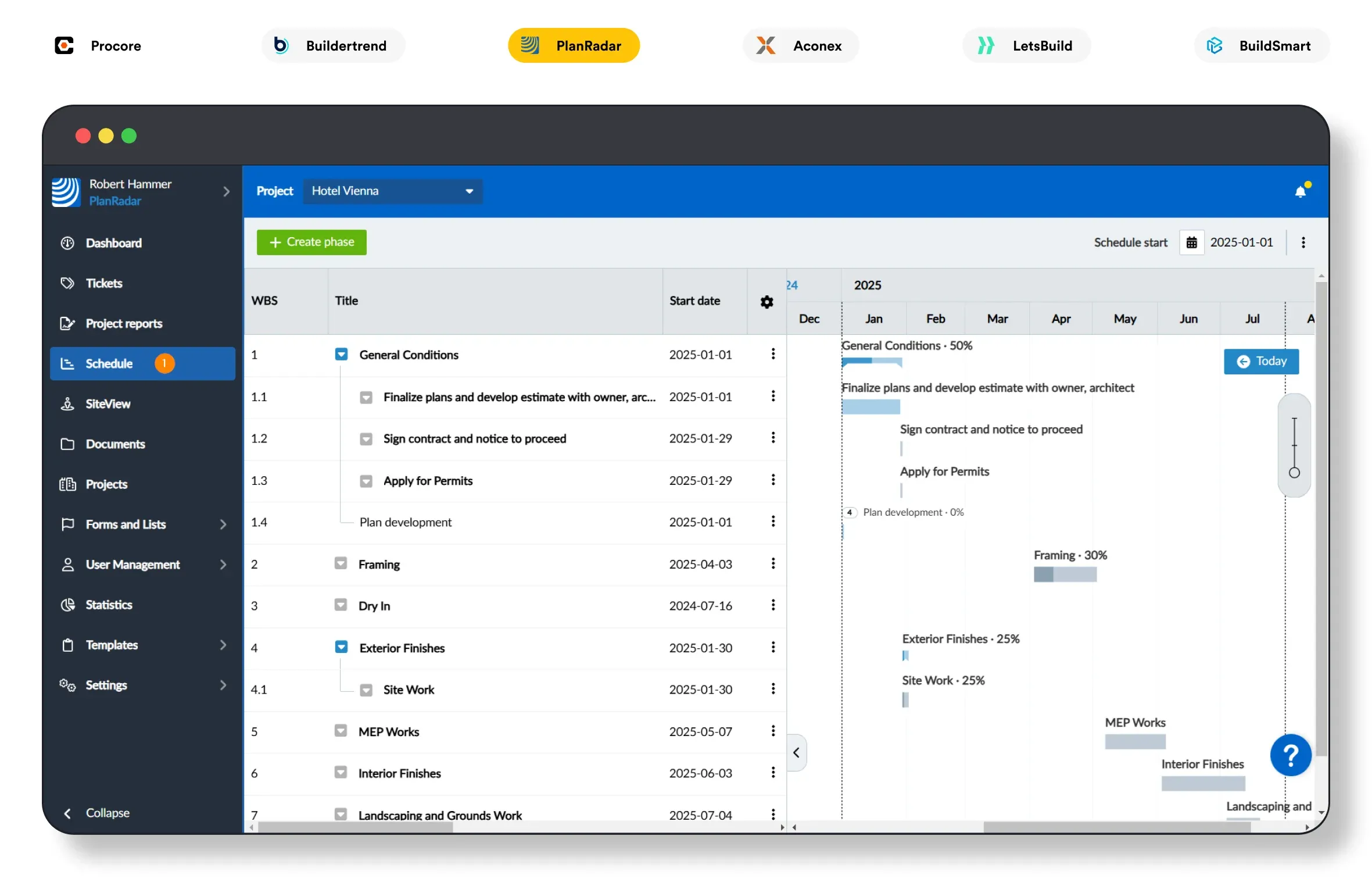
Among the unique strengths of the PlanRadar software for construction management are innovative tools for process automation and digitalization.
-
Advanced on-site mapping and BIM features: PlanRadar offers notable features for communication and progress tracking, such as SiteView, a set of construction site pictures connected to the 2D map, allowing team members to take a virtual walk around the construction site, compare it with previous dates, and more. Apart from that, it will enable workers to leverage design coordination by adding annotations on the construction site blueprints, maps, or even BIMs.
-
Digital documentation: Users can store and share documents in PDF or other file formats on the platform, as well as share them within the platform, and define access to each separate document.
-
Built-in tools for enhanced quality control and risk mitigation: These construction project management software instruments enable users to identify issues early, track them comprehensively, and conduct quality inspections to minimize rework and improve outcomes.
-
Repetitive task automation and task template creation: PlanRadar software scales easily with business needs, offering built-in solutions to enhance routine efficiency. This enables teams to automate operations, freeing up time for more critical tasks.
Weaknesses of PlanRadar
At the same time, the PlanRadar platform lacks some popular features commonly found in construction software and customization options.
-
Lack of specialized workflow customization: Some industry-specific services, such as custom dimensions on plans or advanced 3D model handling, are among the most critical functional gaps. Still, it supports standard Building Information Modeling (BIM) functionality.
-
Digital documentation lacks seamless file export: It can be challenging to export and import certain file types or integrate PlanRadar with other software applications and systems for data sharing. What’s more, the available storage is limited, depending on the chosen subscription plan.
-
Complex for non-tech-savvy users: PlanRadar requires some experience and practice, making it more challenging for new businesses to migrate to this platform seamlessly. For instance, template management and navigation, despite their usability, require some time to get acquainted with.
-
Limited user rights: not everyone can implement changes or annotations, which limits the efficiency of communication and collaboration and requires the involvement of other specialists with higher credentials.
Aconex
Price: 49$/month (per user, five users minimum) Best for: Large compliance-heavy projects

Aconex seems to be quite similar to all the foregoing construction project management software solutions. Just like the rest, it offers construction management essentials as a basic functionality. Yet, it addresses some imperfections of alternative systems, such as PlanRadar or Buildertrend.
-
Prioritized collaboration within the platform: by providing all employees with standardized models, templates, documents, and various workflows, Aconex facilitates easier sharing and access to required information.
-
A single centralized hub for 3D models and documentation: It helps ensure that everyone works with the latest versions, preventing potential mistakes or issues from occurring.
-
Flexible and efficient process management engine: Best project management techniques and features help streamline operations, reduce rework and issue fixes, saving time and resources while keeping the project on time and within the planned budget.

- A mobile version of the app: This feature significantly enhances the user experience and improves accessibility, allowing employees to stay informed and access data from anywhere. So, staff can be more engaged and communicate much faster, also being able to check the latest documentation or models if needed.
Aconex Issues
Despite its numerous features and services, Aconex faces some issues and challenges that can be crucial in certain instances.
-
Limited customization options: Aconex lacks the ability to create custom inquiries despite its rich configuration options. It includes forms or reports, forcing companies and their employees to adjust to the existing solutions.
-
Issues with integrating third-party systems: As part of Oracle products, it can work seamlessly with this ecosystem. However, it might conflict with other solutions and software tools, especially those that are outdated or incompatible.
-
Specific issues with managing and updating ongoing workflows: Adding new participants to the initiated workflow commonly causes problems. The same is true for version control of existing projects or workflows.
-
Multi-project management is also off the table: Aconex is an excellent solution for managing a single project at a time, providing users with multiple tools for setting up and managing each workflow or task. Yet, when it comes to scaling the number of projects, it cannot compete with Procore or similar enterprise-level solutions.
-
This system needs some UX/UI improvements: There are numerous reports that indicate that the user interface is not intuitive and clunky. Additionally, the documentation search is outdated, requiring a complete match with the file name, and lacks sorting features.
LetsBuild
Price: 20$/month (per user) Best for: small-medium construction firms
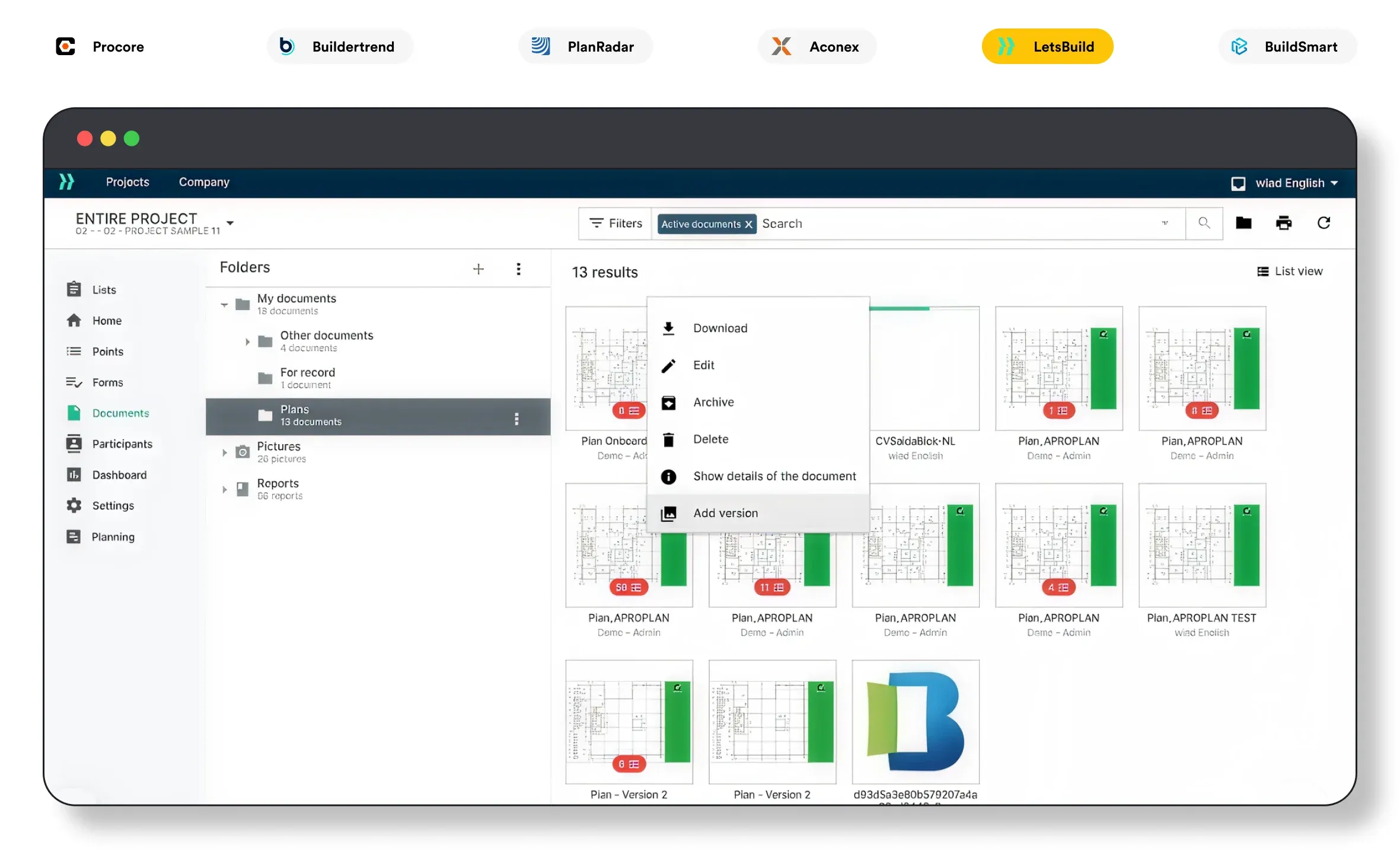
Let’sBuild construction management software prioritizes the usability of its solution, ensuring it is as user-friendly and intuitive as possible.
-
A mobile version for on-site workers: It allows employees to access and update important information about various processes, their progress, and other relevant details. The mobile app can also operate in offline mode, so changes will be updated regardless of whether an Internet connection is available at the moment.
-
Rich customization options: Adjustable reports, templates, checklists, and forms enable users to tailor project specifics and help standardize project management. Such standardization also helps streamline reports by utilizing algorithms to process and summarize input information.
-
Scalability on demand: Thanks to the support of multiple popular planning tools, the functionality can be scaled using third-party services. Therefore, construction companies can enhance functionality by integrating missing tools or features.
-
A free trial plan: Let’sBuild offers a free version that allows users to try out its services, even balancing the budgets of the smallest companies, providing them with the most essential features at no cost.
LetsBuild Drawbacks
Despite the variety of features, this platform has some negative flip sides for almost every one of the offered services.
-
Requires technical skills to set up: Let’sBuild has a knowledge bar, particularly when utilizing its customization features. Therefore, businesses without IT specialists on board may struggle with issues when adopting this system.
-
Services offered for free are limited: The free “trial” also has a limited number of seats for employees. So, when your team or project scales, you might face the need to either find another software or pay extra for the required functionality. It can make a huge difference, considering the rapidly escalating costs of subscription plans.
-
Targeted at small to mid-sized companies: Let’sBuild is not the best choice for enterprises or businesses that aim to scale rapidly.
BuildSmart
Price: 3,472$ one-time ERP license Best for: Medium-large contractors and enterprises
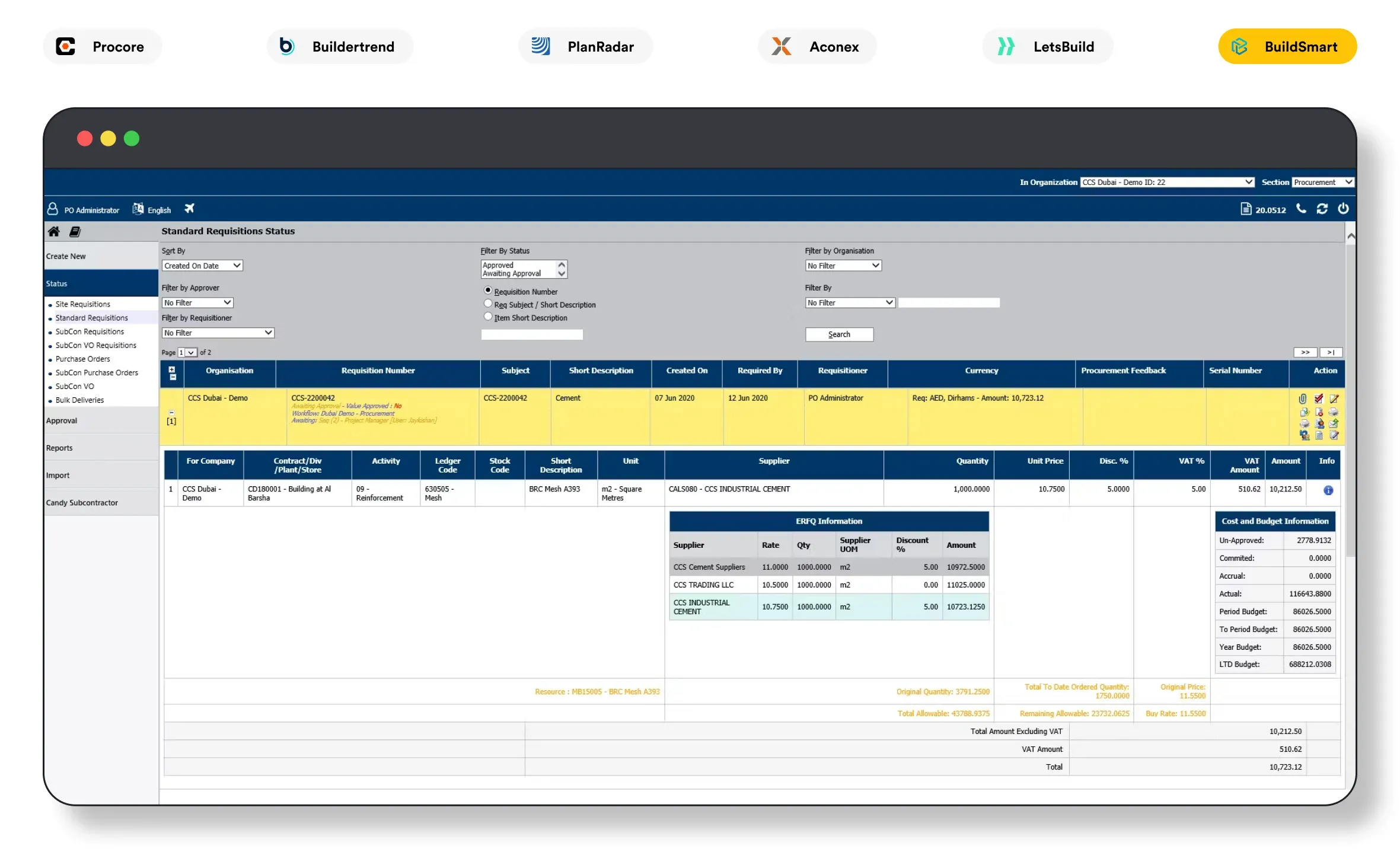
BuildSmart is the complete opposite of Let’sBuild, being designed specifically for enterprise-level construction companies. As a result, it offers excellent experience and functionality for maintaining multiple projects, teams, or other factors. Among the core unique features of the BuildSmart platform are:
-
An all-in-one platform that covers nearly all aspects of construction business management: BuildSmart offers features for project management, financials, procurement, payroll, and asset management, within a single, web-based system. Besides, web-based nature also improves usability, allowing users to access the application from various devices.
-
Highly detailed and efficient services for various project aspects: Built-in tools for financial control and management can function as an independent system, providing all the essentials, such as real-time budget tracking, handling complex requirements like job costing, and subcontractor payments.
-
Compliance with financial industry standards: To achieve this, the platform incorporates features that facilitate compliance with International Financial Reporting Standards (IFRS).
BuildSmart Disadvantages
Integrating and setting up the BuildSmart platform is a complicated process that requires certain technical expertise.
The best way to set up the BuildSmart system is to find a dedicated specialist, as you will need such expertise again when implementing any changes or adjustments. Additionally, such experts can be utilized to resolve issues and manage process automation. Customization and integration with other systems will also require a software specialist on board.
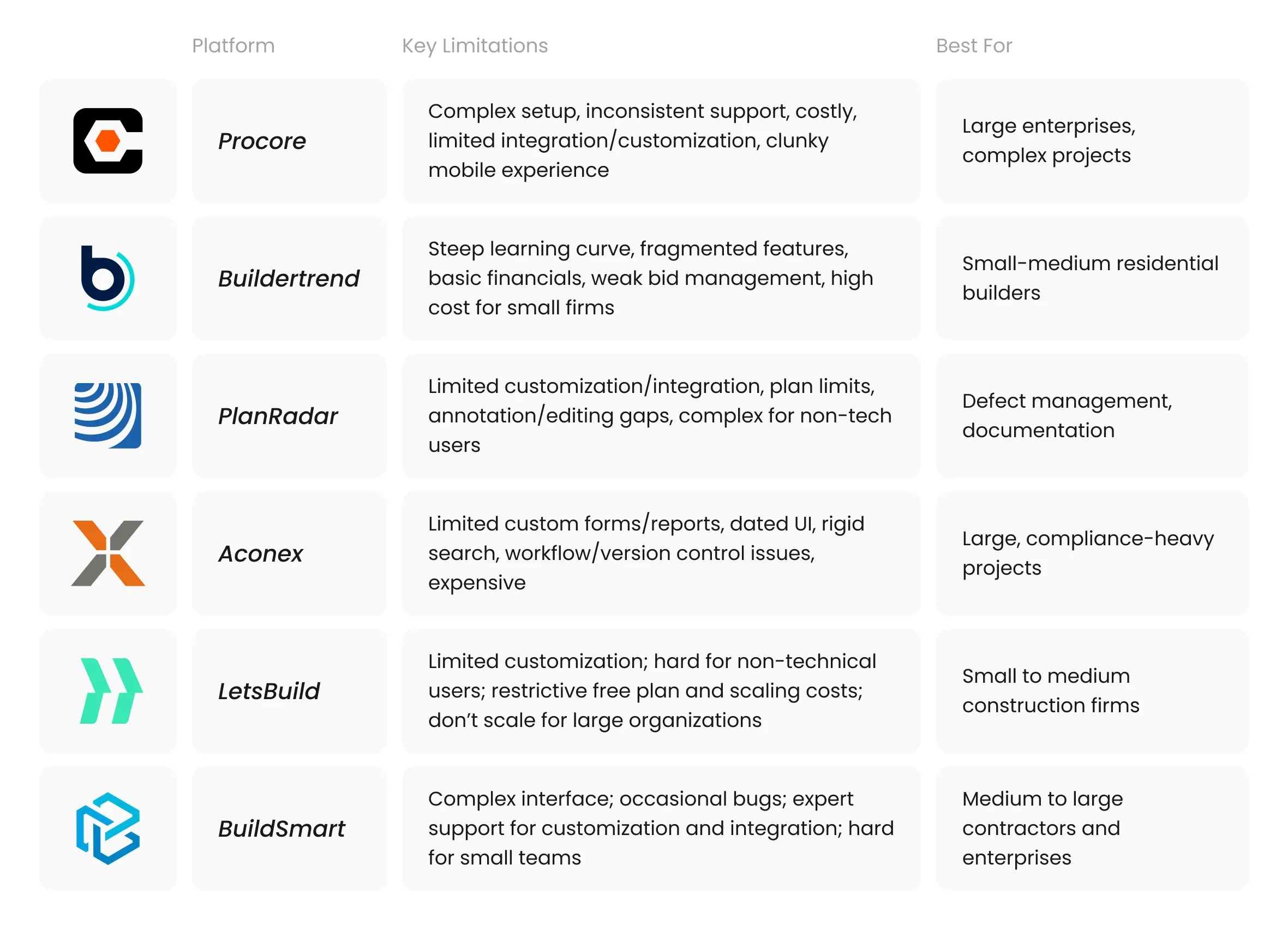
-
Complex interface, hard to navigate: UI is overcrowded with multiple options and features, making it challenging for some users to navigate and use. This also requires some time for your team to become familiar with the platform before utilizing all the available features and services.
-
Built-in accounting tools are limited and rigid compared to other existing general-purpose accounting software. For example, with a proper toolset and integration approach, it is possible to achieve much better results by combining two separate systems: one for construction workflow management and another for budgeting and finance.
-
Complex and complicated for small and mid-size construction companies: BuildSmart is offering multiple features that they won’t use. Apart from complicating your employees, this can also impact your pricing, resulting in your company paying extra for services that are not utilized.
How Can Integrating Custom Features Enhance Ready-Made Software Solutions?
There is no such thing as ideal one-size-fits-all software for construction management. Each ready-made or even custom software solution will have drawbacks and limitations. Nevertheless, it doesn’t mean that there is no ideal construction project management software when it comes to your particular case.
Construction companies often opt for ready-made SaaS solutions that cover the most crucial aspects of the job, while retaining old-fashioned processes that are not addressed by off-the-shelf software. Therefore, a tiny percentage of such businesses pay attention to customization capabilities of ready-made software, as well as its compatibility with other solutions.
However, what if we told you that it is the most essential criterion to consider when choosing construction project management software? Long story short, custom software development is an excellent way to address weaknesses, upgrade, and scale an off-the-shelf software solution, which is also not as expensive as it may seem.

However, benefiting from such practices is possible only if the chosen SaaS system supports such third-party activities and integrations.
Thanks to cooperation with custom software development teams, construction businesses can scale and upgrade existing systems, integrate innovative features and services, or optimize ongoing operations without waiting for a SaaS vendor to do so. Ultimately, custom development can be leveraged to integrate disparate systems and synchronize them.
What’s your impression after reading this?
Love it!
10
Valuable
12
Exciting
5
Unsatisfied
1
FAQ
Let us address your doubts and clarify key points from the article for better understanding.
How can software help automate construction operations?
Software can automate construction operations by streamlining project management, scheduling, budgeting, equipment tracking, and real-time communication—reducing manual errors and improving efficiency by up to 30–50%.
How can AI be used in construction automation?
AI can automate construction by optimizing scheduling, predicting delays, enhancing safety with real-time monitoring, and improving quality control—cutting costs by up to 20% and boosting productivity by 30%.
What kind of ROI can we expect from automating our construction processes?
Automating construction processes can deliver an ROI of 20–40% through reduced labor costs, fewer delays, improved resource utilization, and enhanced project accuracy.
Can you automate construction processes using our current systems?
Yes, many construction processes can be automated using your current systems by integrating automation tools or AI modules—often without the need for a full system overhaul.
you may also like
Management Systems
Construction Project Management Software for Small Business: Complete Guide
Management Systems
Simple Construction Software for Construction Planning: Case Study
Real Estate
Clutch: Incora Is Among the TOP 10 Best Real Estate Software Development Companies Worldwide!
Must-Have Features for Successful Real Estate Mobile App Development in 2024
Real Estate App Development vs Web Development: Which is Right for Your Business?
Let’s talk!
This site uses cookies to improve your user experience. Read our Privacy Policy
Accept
Share this article